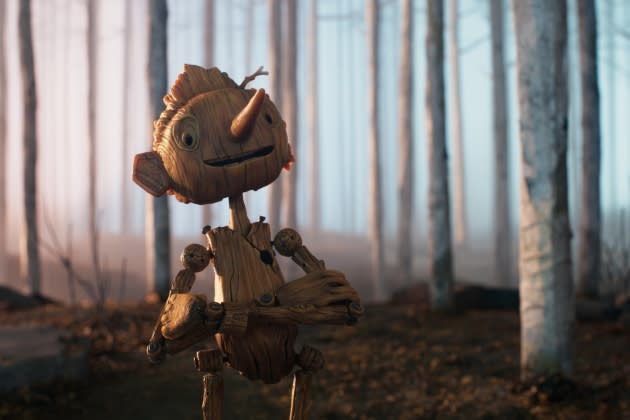‘Guillermo Del Toro’s Pinocchio’ Producers Alex Bulkley & Corey Campodonico On Bringing Del Toro’s Vision To Life
- Oops!Something went wrong.Please try again later.

After joining Guillermo del Toro on the project over 10 years ago, producers Alex Bulkley and Corey Campodonico finally got to see the fruits of their labor when Guillermo del Toro’s Pinocchio premiered last year. Del Toro’s Netflix adaptation of the Carlo Collodi story takes place in 1930s Italy, during the Fascist reign of Benito Mussolini. In this story, woodcarver Geppetto (David Bradley) loses his son Carlo in an aerial bombing and carves Pinocchio (Gregory Mann) from the tree at his son’s grave. Bulkley and Campodonico’s animation studio, ShadowMachine, was responsible for the stop-motion animation of the film, and the pair were incredibly excited to go on this long journey with del Toro.
DEADLINE: What excited you about Guillermo del Toro’s version of the Pinocchio story?
More from Deadline
COREY CAMPODONICO: What is so cool about a property that’s been touched throughout the years and is such an iconic property, is a specific specificity that I think Guillermo had. And obviously he was inspired by the Gris Grimley version of the character for what Pinocchio was actually going to look like. There’s a real indie spirit to the movie, even though it’s at a massive scale and a huge undertaking it also has the fabric of a really powerful singular auteur vision that’s coming from Guillermo and Mark [Gustafson]. And that’s really what Alex and I are always attracted to, regardless of what the project is. And I think us as a studio kind of fall into that mold as well. So, anything that takes a ton of work, is extremely difficult and has a message and a meaning, which this film beautifully does, has a real connection point to the heart that we’re usually interested in and obviously Guillermo comes with a long history of incredible filmmaking that we were humbly fortunate to be a part of.
DEADLINE: So it was a 10 year process, how long was the animation process itself?
ALEX BULKLEY: Yeah, somewhere in 2018, we started the process when we found our partnership in Netflix. There’s a long pre-production on-ramping when it comes to Guillermo and Patrick [McHale] tinkering the script with the animatic process, and of course the fabrication where you get in and you actually make all the puppets. So, that took us all the way through 2019 into the notorious 2020 pandemic era. Luckily for us, we’d only just begun shooting, but it allowed for us to continue because a lot of that work in the animatic, early R&D puppet builds and set designs were all able to be done over a remote work. But really, we never shut down. Everyone was able to keep moving. We like to say it was close to a thousand days of production, and that really included the whole envelope from start to finish. Animation’s a tedious, meticulous format and throw in a global pandemic and it gets a little more challenging. But, it’s a testament to a really dedicated crew. The fortitude that went into every single frame, the passion that went into every single frame was just incredible.
CAMPODONICO: The lucky thing for this film was that Netflix supported this thing from day one at a really, really high level. As soon as the pandemic hit, all the crew rallied together to get through this production in such a meaningful way.
DEADLINE: Talking about how meticulous animation is, it’s very different from live action in that nothing happens by accident. Everything needs to be planned out.
CAMPODONICO: That’s a really good point, and definitely a hundred percent true in every format of animation, but particularly in stop-motion. One of the things that Guillermo touted from the beginning is making sure that you are animating all the regular human gestures that we’re all accustomed to, but are irregular and not necessarily needed. That’s what brings the characters in this movie to life in such an interesting way and it really gives a lifelike quality to the animation that you don’t typically see in animation, because everything is so planned and nothing does happen by accident. You have to plan accidents in our human articulation.
DEADLINE: What is it that makes this version of Pinocchio so unique?
BULKLEY: It’s an easy answer and it’s that Guillermo had something to say in this this story, and this film really became a voice for him to say it. Pinocchio is a foundational story about a creator and the created, in this idea of what is life, what is love and the meaning of those two. And there’s a reason it’s called Guillermo del Toro’s Pinocchio you know, we had a lot of incredible talent involved in this project. Literally the best stop-motion team and crew on the planet all came to really back up his idea. Undeniably, that’s what makes it special from the start.
CAMPODONICO: The truth is that every good project, regardless of format, regardless of story, comes from a place of passion and intimacy within the actual story. Guillermo talked about that a ton, as far as how it affected his childhood and where it came from, and you can really hitch your wagon to that passion. And it follows from the first day of getting together to the very last. And that’s the quality of any good project.
Best of Deadline
Oscars: Every Best Supporting Actor Oscar Winner Back To 1937
Grammy Best New Artist Winners Through The Years – Photo Gallery
Sign up for Deadline's Newsletter. For the latest news, follow us on Facebook, Twitter, and Instagram.
